In today’s fast-paced world, Educational Technology is leading the way in changing how we learn. It makes learning fun and interactive. The digital classroom now offers a place where everyone can learn in their own way.
Teachers in the UK are using these tools to improve their teaching. They make learning easier and more effective for all students. This shows how important these technologies are for today’s education.
Key Takeaways
- Educational Technology is essential for modernising teaching practices.
- Innovative learning tools enhance student engagement and motivation.
- The digital classroom provides flexibility for diverse learning needs.
- Educators can leverage pedagogical tools to improve educational outcomes.
- Technology integration is vital for a contemporary educational framework.
The Impact of Educational Technology on Modern Learning
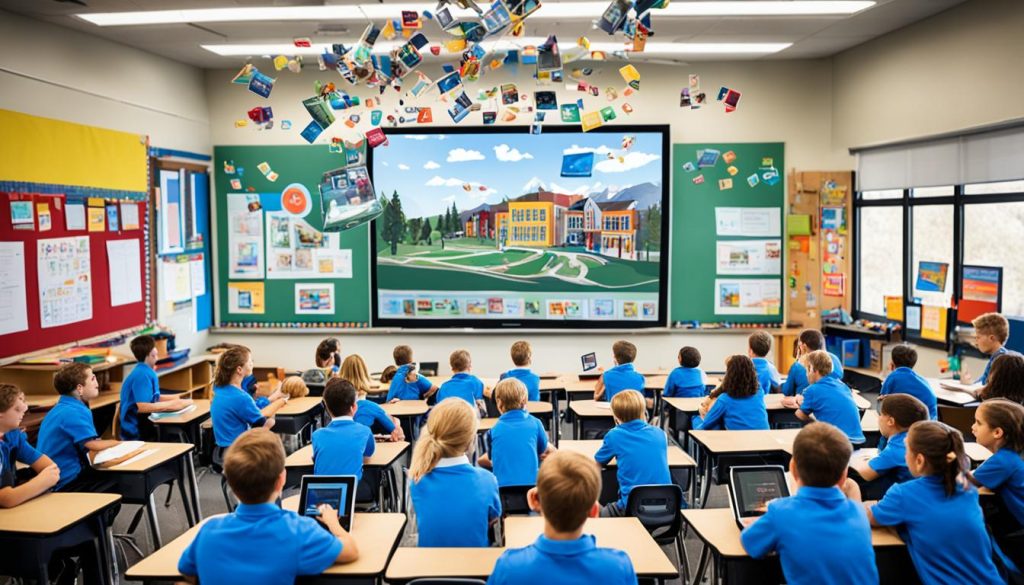
Technology has changed how we learn. It’s not just about getting information. It’s about new ways of teaching that make learning fun and creative. Digital tools offer custom learning paths for different students and learning styles.
Studies by the Education Endowment Foundation show big improvements in maths and science scores. Teachers use tech to make lessons lively with multimedia. Tools like storytelling apps and games make hard topics easier to understand.
Technology helps students work together better. They can learn from each other, even outside class. This teamwork boosts cooperation and makes learning easier for everyone. Access to resources and feedback is key to doing well.
But, there are hurdles in using tech in schools. Teachers need training and the right resources. Making sure tech fits with current teaching methods is crucial for success.
Key Benefits of Implementing Educational Technology

Using educational technology in classrooms brings many advantages. It makes learning more engaging and helps create learning paths that fit each student. Technology lets teachers make learning environments that meet each student’s needs.
Enhancing Student Engagement
Adding technology to lessons makes students more engaged. Research shows that students do better when technology is part of their learning. Tools like games and interactive content make learning fun and different from before.
This makes students more interested in what they’re learning. It helps them connect with the material on a deeper level.
Individualised Learning Paths
Personalised learning is a big plus of educational technology. Teachers can use technology to make learning fit each student’s needs. This way, students learn at their own pace and in a way that suits them best.
Technology helps teachers see how each student is doing. This means students get the help they need to do well in school.
Innovative Tools in Educational Technology
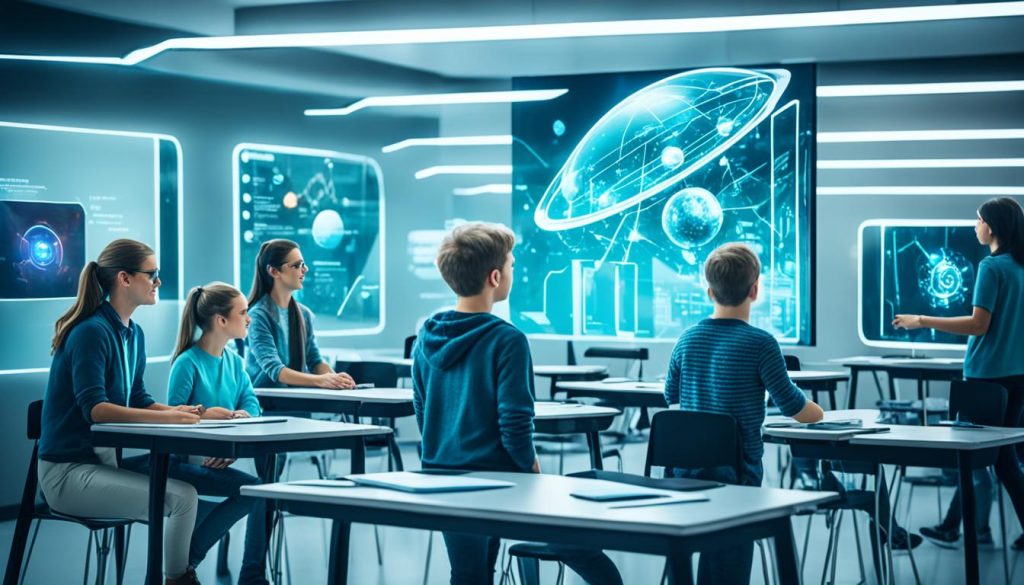
Classrooms are changing thanks to new educational tools, especially interactive learning methods. Teachers now use technology to make learning more engaging and effective. Interactive whiteboards and Learning Management Systems (LMS) are two key examples of this shift.
Interactive Whiteboards
Interactive whiteboards are a big step forward in teaching. They make lessons more dynamic by adding multimedia easily. Teachers use these boards to keep students interested with videos, polls, or discussions.
This approach makes learning more interactive. Students can also write on what’s shown, which helps them work together and stay focused.
Learning Management Systems (LMS)
Platforms like Google Classroom and Moodle are great for learners and teachers. They make managing courses easier and help track student progress. These systems also make it simpler for teachers and students to communicate.
They offer learning paths that match each student’s needs. This means students get the right resources for them. Plus, they make sharing assignments and giving feedback easier, which helps improve learning.
Integrating Educational Technology in UK Classrooms

Adding educational technology to UK classrooms can really improve how teachers teach. Teachers can use different ways to make sure technology fits well in the classroom. This helps meet the National Curriculum goals. By using digital tools, teachers can change old teaching methods. This makes learning more fun and interesting.
Here are some practical ways to make technology work well in the classroom:
- Using interactive platforms that get students involved and working together.
- Adding online tools that help students learn on their own.
- Choosing educational software that fits the curriculum and helps students learn important skills.
In the UK, many schools are doing great with technology. For instance, giving tablets to students has made them more engaged and done better in school. These digital tools let teachers teach in ways that fit different learning styles. They also make checking student progress easier.
Challenges of Adopting Educational Technology

Many schools find it hard to adopt educational technology due to big hurdles. These include not having enough money and not training teachers well enough. It’s key to tackle these issues to make technology work well in schools.
Budget Constraints
Money issues are a big problem for schools wanting to buy tech. They often can’t afford the technology that makes learning better. Looking for grants and government help can ease these money worries. By finding and using these funds, schools can better support technology use.
Training Educators Effectively
Teachers need to be ready to use educational technology well. Without good training, they might get lost with new tools. It’s important to focus on training teachers thoroughly. This helps them use technology in class better and boosts students’ learning.
The Role of Teachers in a Technology-Driven Classroom
Today, teachers have changed a lot because of technology in schools. They’re not just the ones who know everything. Now, they help guide students in a more interactive way. This change shows how important it is to have teachers who can handle technology well.
Technology changes how classrooms work, making them more like a team effort. Students get more involved in their learning. Teachers need to learn new skills to use digital tools well. They must know how to use devices and platforms and add them to their teaching methods to improve learning.
To do well in a tech-filled classroom, teachers should pay attention to these key areas:
- Keep learning new things about educational technology.
- Create a space where students feel free to share their thoughts and questions.
- Use data to make teaching better and meet the needs of all students.
- Help students use technology in a smart and creative way.
Educational Technology and Student Assessment
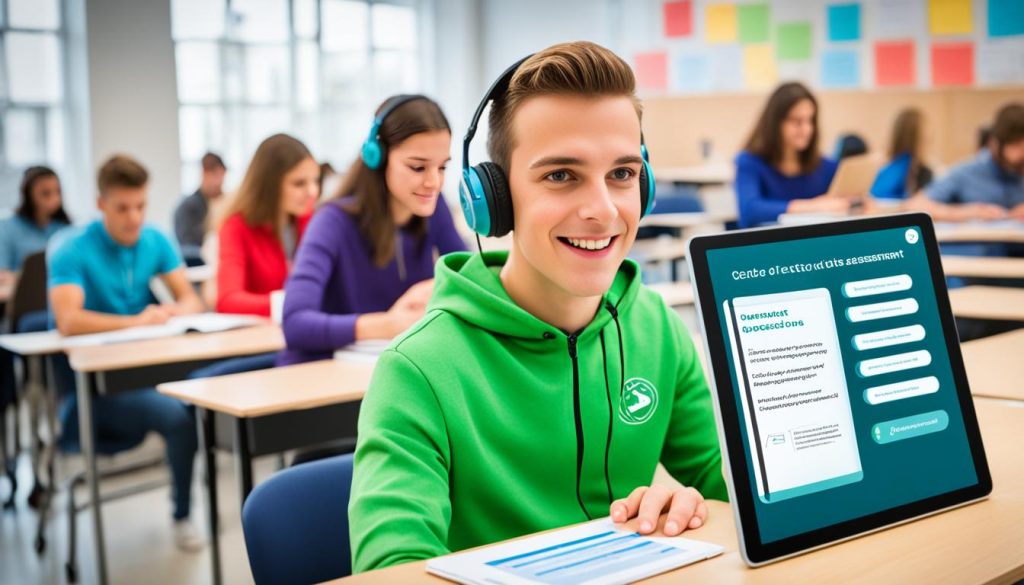
Educational technology has changed how we do assessments and understand them. It lets teachers improve how they check how well students are doing.
Real-Time Feedback Mechanisms
Real-time feedback gives teachers quick insights into what students know. Digital quizzes and interactive tools help teachers see how well students understand. This means teachers can help students who are struggling right away.
They can change their teaching to better fit what students need. This makes learning more effective for everyone.
Data-Driven Insights for Improvement
Data analysis is key in education to track how students are doing and their progress. Through technology, teachers get detailed reports on what students are good at and where they need help. This helps them plan their lessons better.
It also helps improve the curriculum. By looking at trends in student performance, teachers can make targeted changes. This leads to better learning results for all students.
Future Trends in Educational Technology
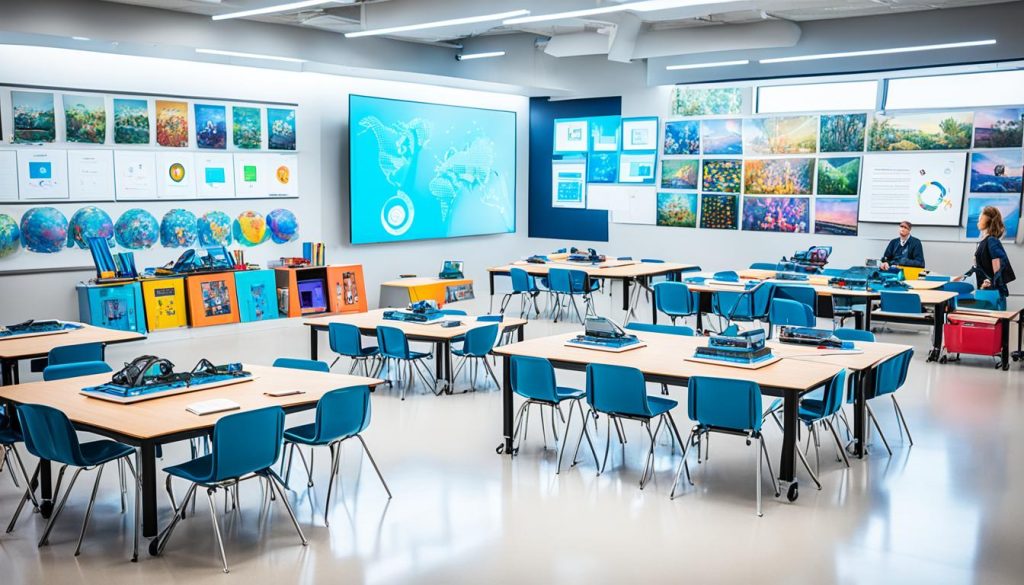
The future of education is set for a big change thanks to new tech. Technologies like Artificial Intelligence (AI), Virtual Reality (VR), and Augmented Reality (AR) are making learning more immersive. They help show complex ideas in new ways, making learning more engaging.
These changes will greatly affect how classrooms work. Teachers will be able to give lessons that fit each student’s needs. AI will help track how students are doing and adjust lessons on the spot.
VR and AR are also set to make learning more exciting. Students will get to explore subjects like history or science in a way that feels real. This makes learning more fun and helps students remember what they’ve learned.
It’s important for teachers to keep up with these tech changes. As new tech comes along, being open to change will help teachers use these tools to their fullest.
Case Studies: Success Stories in Educational Technology
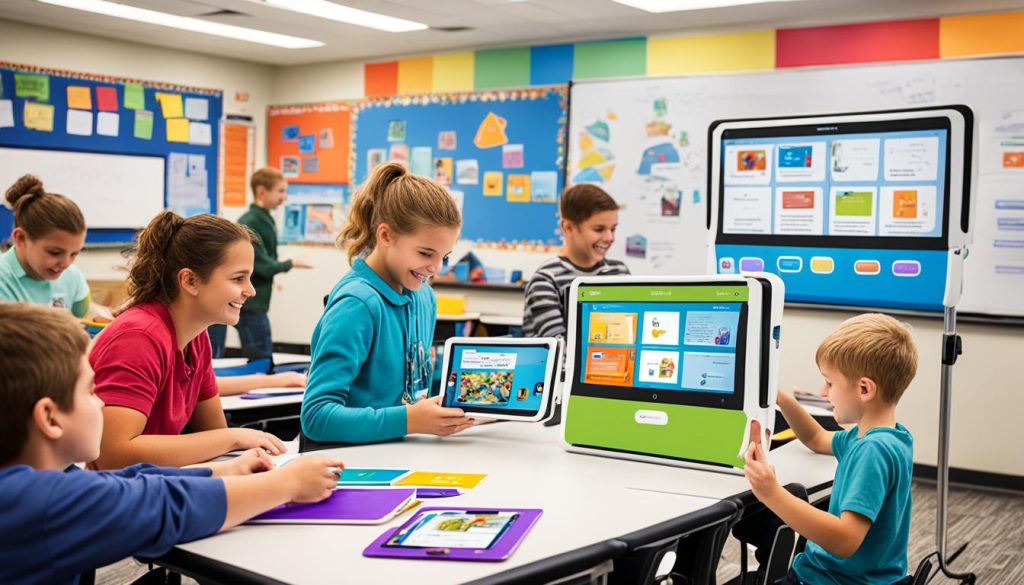
Looking into education, we find amazing success stories in tech for both primary and higher education. These stories show how new tech improves learning and meets today’s education needs.
Adoption in Primary Schools
Primary schools are now using tech more, thanks to coding and digital tools. For example, Paddington Green Primary School has made tech a big part of their teaching. This has brought many benefits, such as:
- More students getting involved in their learning.
- Better critical thinking through solving problems.
- Happy parents seeing their kids love learning more.
Innovative Approaches in Higher Education
Higher education is also changing with new tech. Places like the University of Manchester are using online tools for teamwork and learning from anywhere. These efforts have led to:
- Helping students with different needs.
- Keeping everyone updated with digital dashboards.
- Bringing together different departments for teamwork.
Parental Involvement with Educational Technology
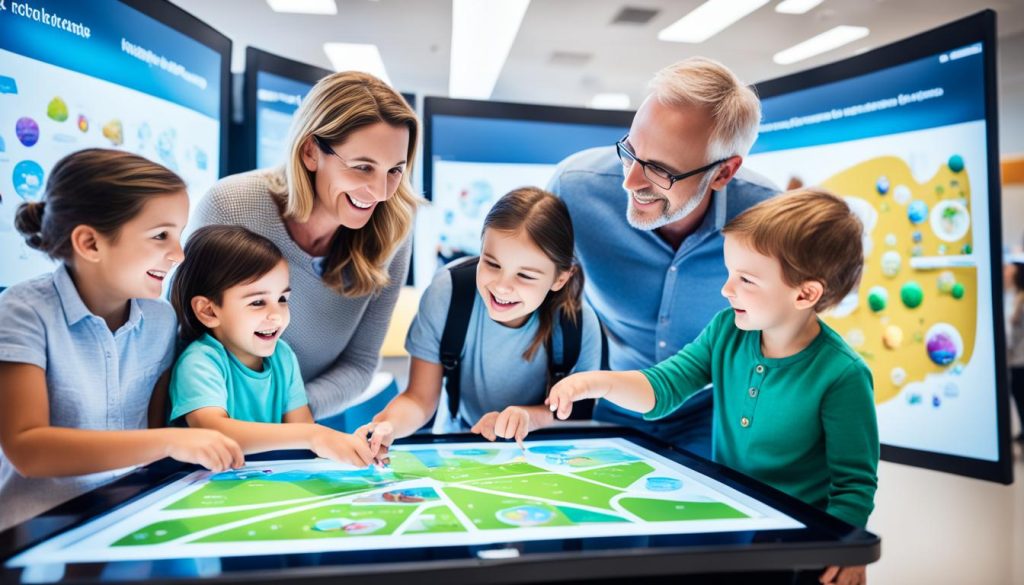
Parents play a key role in making the most of educational technology for their kids. When parents get involved, they create a supportive home atmosphere. This helps students do better in school by using technology.
Schools can help bridge the gap between home and school by using smart strategies. They can offer workshops that teach parents about the educational tools their kids use. These workshops might cover how to use learning systems or apps to help with homework.
Newsletters about technology in the classroom can also keep parents updated. This way, parents can stay in touch with what their kids are learning.
Studies show that when parents get involved, students do better in school. This shows how important it is for parents and schools to work together. By getting parents more involved, schools can make learning better for everyone. This partnership helps parents feel more involved in their child’s education. It also makes sure students can succeed in a world full of technology.
Best Practices for Effective Educational Technology Integration
Integrating educational technology into the classroom requires following best practices. This means teachers must keep learning new skills. They need to know how to use modern tools well.
Teacher training is key to learning how to use technology right. It helps teachers improve their teaching methods. This makes learning better for students.
Professional Development for Teachers
Teachers need special training to use educational technology well. Workshops and training help teachers feel ready to use new tech. This makes them more confident in teaching.
These training sessions also help teachers find new ways to teach. This can make students more interested in learning.
Collaborative Learning Environments
Creating a place where students work together is important. Tools like Google Classroom and Microsoft Teams help with this. They let students work on projects together.
This teamwork helps students learn important skills. It also makes learning more fun and inclusive. This creates a better learning environment for everyone.











